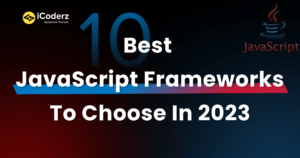Table of Contents
Node.js has emerged as one of the most powerful and widely adopted platforms for backend development. By enabling JavaScript to run on the server, Node.js developers to build fast, scalable, and efficient applications. However, building applications solely with raw Node.js can be challenging and time-consuming. That’s where Node.js frameworks come into play.
Frameworks simplify development by providing ready-to-use modules, enforcing best practices, and offering pre-built structures for routing, middleware, and database integration. Whether you’re a startup developer, an enterprise CTO, or a seasoned backend engineer, choosing the right Node.js framework can drastically improve your productivity, scalability, and maintainability.
In this article, we’ll explore the best Node JS frameworks in 2025, their benefits, and types, and provide actionable tips to help you choose the framework that aligns perfectly with your project needs.
What is a Node JS Framework?
A Node.js framework is a set of libraries, tools, and design patterns that streamline server-side development. Unlike raw Node.js, frameworks provide pre-built solutions for common tasks such as:
- Routing requests
- Handling middleware
- Database management
- Authentication and security
Using a framework allows developers to focus on building unique features rather than reinventing the wheel. Popular Node.js frameworks include Express.js, NestJS, Meteor.js, Koa.js, Sails.js, and LoopBack. Each framework has its own strengths, making it suitable for different types of applications.
Raw Node.js vs Frameworks:
| Feature | Raw Node.js | Node.js Framework |
| Routing | Manual implementation | Built-in or modular routing |
| Middleware | Custom implementation | Pre-configured middleware support |
| Scalability | Depends on developer expertise | Structured patterns and modules for scalable apps |
| Security | Developer responsibility | Often includes built-in security features |
| Development Speed | Slower | Faster with pre-built templates and modules |
Why Use a Framework?
Using a Node.js framework provides several advantages:
- Speeds Up Development: Pre-built modules and templates reduce repetitive coding.
- Organized Code Structure: Frameworks enforce patterns that help maintain clean, readable code.
- Scalability: Designed to handle growth, frameworks can efficiently manage large user traffic.
- Simplifies Common Tasks: Routing, authentication, database queries, and error handling are streamlined.
- Community Support: Frameworks often have active communities offering plugins, updates, and troubleshooting support.
Types of Node.js Frameworks
Node.js frameworks can be classified based on their architecture and use cases:
1. Full-Stack Frameworks
- Example: Meteor.js
- Provide end-to-end solutions, including frontend and backend.
- Ideal for startups building MVPs quickly.
- Features include real-time data updates, built-in authentication, and database integration.
2. Micro/Minimalist Frameworks
- Examples: Express.js, Koa.js
- Lightweight and flexible.
- Provide just the essentials, allowing developers to choose additional tools as needed.
- Ideal for small to medium-sized applications with custom requirements.
3. Real-Time Frameworks
- Example: Socket.io
- Specialized for real-time applications like chat apps, gaming platforms, and live dashboards.
- Handles WebSocket communication efficiently.
4. Enterprise-Grade Frameworks
- Example: NestJS
- Modular, TypeScript-first architecture designed for large-scale, enterprise applications.
- Supports dependency injection, testing, and maintainable patterns.

Top Node JS Frameworks in 2025
1. Express.js
- Overview: Express.js is the most popular Node.js framework and is often called the “de facto standard” for server-side Node.js development. It is minimalist, unopinionated, and extremely flexible, allowing developers to structure projects the way they want.
- Key Features:
- Middleware support for request handling
- Easy routing
- Template engines support (EJS, Pug, Handlebars)
- HTTP utilities and robust API development
- Middleware support for request handling
- Use Cases: REST APIs, web apps, microservices
- Pros: Lightweight, vast community, huge npm ecosystem
- Cons: Less structured, so large apps may require extra architectural planning
- Real-World Example: IBM, Uber – using Express for scalable web services
2. Koa.js
- Overview: Developed by the creators of Express.js, Koa.js is more modern and modular, designed to leverage async/await patterns to avoid callback hell.
- Key Features:
- Lightweight and modular
- Improved error handling with async/await
- Minimal footprint (you choose the components you need)
- Lightweight and modular
- Use Cases: Small-to-medium apps, API services
- Pros: Modern syntax, lightweight, high performance
- Cons: Smaller community than Express, more manual setup required
- Real-World Example: Alibaba – uses Koa.js for performance-critical services
3. NestJS
- Overview: NestJS is a TypeScript-first, enterprise-grade framework that brings structure and scalability to Node.js development. It draws inspiration from Angular and uses a modular architecture.
- Key Features:
- Dependency injection
- MVC pattern support
- Built-in testing utilities
- GraphQL and WebSocket support
- Dependency injection
- Use Cases: Large-scale enterprise applications, microservices, scalable APIs
- Pros: Highly maintainable, modular, enterprise-ready
- Cons: Steeper learning curve, TypeScript required
- Real-World Example: Adidas, Capgemini – large enterprise apps
4. Meteor.js
- Overview: Meteor.js is a full-stack JavaScript framework designed for real-time applications. It allows developers to write both client-side and server-side code using the same language.
- Key Features:
- Use Cases: Chat apps, live dashboards, MVPs
- Pros: Rapid development, real-time updates, unified stack
- Cons: Heavyweight, less flexible for large modular applications
- Real-World Example: Rocket.Chat – real-time messaging app
5. Sails.js
- Overview: Sails.js is a Model-View-Controller (MVC) framework designed for building data-driven APIs and enterprise-grade applications.
- Key Features:
- Auto-generated REST APIs
- Waterline ORM for database integration
- WebSocket support
- Auto-generated REST APIs
- Use Cases: Data-intensive applications, APIs, backend dashboards
- Pros: Fast API development, MVC pattern, WebSocket ready
- Cons: Slightly heavier and opinionated structure
- Real-World Example: Postman API – building backend dashboards and services
6. LoopBack
- Overview: LoopBack is a highly extensible framework focused on API creation and database integration. It supports connecting to multiple data sources and generating REST APIs quickly.
- Key Features:
- OpenAPI support
- Multi-database connectors (MySQL, MongoDB, PostgreSQL, Oracle, etc.)
- Built-in authentication and role-based access control
- OpenAPI support
- Use Cases: API-first applications, enterprise backend services
- Pros: API-focused, scalable, secure, easy database integration
- Cons: Can feel complex for simple apps
- Real-World Example: GoDaddy – API-driven enterprise systems
How to Choose the Best Node.js Framework
Choosing the right framework depends on multiple factors:
1. Project Type
- Small App: Lightweight frameworks like Express.js or Koa.js are ideal.
- Enterprise App: Modular frameworks like NestJS or LoopBack ensure maintainability.
2. Scalability & Performance
- Evaluate if the framework can handle your projected user growth.
- NestJS and Koa.js are known for high-performance backends.
3. Community Support & Documentation
- Frameworks with active communities like Express.js and NestJS offer better long-term support.
- Comprehensive documentation ensures faster onboarding for your team.
4. Learning Curve
- Choose a framework that matches your team’s expertise.
- Express.js is beginner-friendly, while NestJS may require TypeScript knowledge.
5. Built-in Features vs Flexibility
- Full-featured frameworks like Meteor.js reduce setup time but can be less flexible.
- Minimalist frameworks like Koa.js offer freedom but require more configuration.
6. Third-Party Integration
- Ensure compatibility with databases, APIs, and services your project depends on.
- LoopBack excels at integrating with multiple database types.
Key Factors to Consider When Choosing a Node.js Framework
- Project Complexity: Match framework capabilities with your app size.
- Scalability: Ensure it can handle both current and future traffic.
- Community & Support: Active communities improve problem-solving speed.
- Learning Curve: Consider onboarding time for new developers.
- Built-in Features: Decide between out-of-the-box functionality vs custom solutions.
- Integration Compatibility: Check for database and third-party API support.
Expert Tips for Node.js Framework Selection
- Prototype First: Try building a small feature in multiple frameworks to see which fits best.
- Check Popularity Trends: Use GitHub stars, npm downloads, and Stack Overflow activity.
- Consider Long-Term Maintenance: Choose frameworks with consistent updates and strong community engagement.
- Align With Team Skills: Match TypeScript vs JavaScript expertise with framework choice.
- Focus on Project Goals: Don’t overcomplicate with enterprise-grade frameworks for simple apps.
Conclusion
Node.js frameworks are essential for building fast, scalable, and maintainable applications. Choosing the right framework can significantly reduce development time, improve code quality, and simplify scaling as your project grows.
Whether you are a startup looking for a rapid MVP or an enterprise aiming for a robust backend solution, there is a Node.js framework tailored to your needs. Evaluate project complexity, scalability, community support, learning curve, and integration requirements to make an informed choice.
Ready to start your next project?
Our Node.js experts can help you pick the perfect framework and build scalable, high-performance applications.




